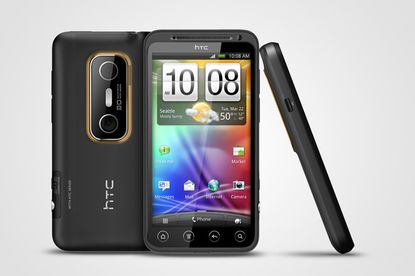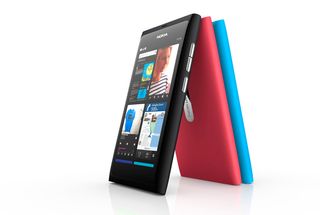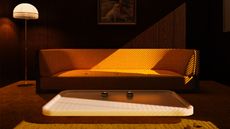The Nokia N9 vs HTC 3D

HTC continues its relentless deluge of new product with the EVO 3D, formerly a US-only product that is now making its way to Europe. Although the 3D is equipped with a 3D capable (i.e. twin lens) camera, the 4.3 inch screen uses clever dual-layer trickery to mimic a 3D-style effect without the need for additional glasses (thankfully). Will this prove more than a gimmick? Possibly not, but the good news is that the EVO 3D has plenty of power and memory to offer a seamless Android 2.3 experience even if you don't go all out on the bells and whistles
Assessing a mobile phone without a lengthy hands-on appraisal is a pretty tall order. The world cottoned on pretty swiftly to the tactile delight of the original iPhone and its descendants, and now that the smartphone OS wars has settled into an us-and-them groove of Android versus iOS, it's safe to say that most people have an inkling of what to expect from their phone even before they've opened the box.
So mobile manufacturers need gimmicks and innovations to keep consumers keen and encourage them to switch from one eco-system to another. The latest flagship phones from two key smartphone contenders offer different approaches. Nokia has had a troubled year and the imminent collaboration with Microsoft marks a new chapter in the company's long history. But before it brings out a Windows 7 phone it's offering a last-chance at an alternative.
The new N9 runs MeeGo, a Linux-based OS that promises to do everything its rivals can and more, with collaboration from Intel to ensure hardware and software are perfectly matched. The polycarbonate-bodied phone is certainly slick enough, featuring Nokia's trademark high quality hardware design (their camera quality is usually second to none.) Dolby surround sound, 8 megapixel camera, a 3.9 inch screen and inbuilt in-car navigation functions all add up to a competitive package.
However, speed, slickness and functionality won't necessarily overcome the massive headstart both iOS and Android have in the market, with hundreds of thousands of Apps and swelling user bases (Google are currently claiming over half a million new Android devices are being activated every single day). Nokia are bigging up the N9's ease of use - no buttons, just a single swipe to go to the home page - and MeeGo is also open source - arguably even more so than Android. That should help grass roots support spring up around the world even though the Microsoft hook-up isn't great news for future updates and evolutions. For tinkerers who want to think different, it could be a smart choice.
HTC continues its relentless deluge of new product with the EVO 3D, formerly a US-only product that is now making its way to Europe. Although the 3D is equipped with a 3D capable (i.e. twin lens) camera, the 4.3 inch screen uses clever dual-layer trickery to mimic a 3D-style effect without the need for additional glasses (thankfully). Will this prove more than a gimmick? Possibly not, but the good news is that the EVO 3D has plenty of power and memory to offer a seamless Android 2.3 experience even if you don't go all out on the bells and whistles. With the iPhone 5 just round the corner, plus a new version of Android imminent, the only sure prediction is for ongoing rapid change.

The new Nokia N9 runs MeeGo, a Linux-based OS that promises to do everything its rivals can and more, with collaboration from Intel to ensure hardware and software are perfectly matched. The polycarbonate-bodied phone is certainly slick enough, featuring Nokia's trademark high quality hardware design (their camera quality is usually second to none.) Dolby surround sound, 8 megapixel camera, a 3.9 inch screen and inbuilt in-car navigation functions all add up to a competitive package
Wallpaper* Newsletter
Receive our daily digest of inspiration, escapism and design stories from around the world direct to your inbox
Jonathan Bell has written for Wallpaper* magazine since 1999, covering everything from architecture and transport design to books, tech and graphic design. He is now the magazine’s Transport and Technology Editor. Jonathan has written and edited 15 books, including Concept Car Design, 21st Century House, and The New Modern House. He is also the host of Wallpaper’s first podcast.
-
 Elias Sime reflects on the destructive nature of technology in Venice
Elias Sime reflects on the destructive nature of technology in VeniceIn his solo show ‘Elias Sime: Dichotomy ፊት አና ጀርባ’ at the Venice Biennale 2024, the artist spotlights technology's destructive nature for humans and the environment
By Gameli Hamelo Published
-
 Knoll presents Willo Perron sofa at Salone del Mobile 2024, 'a piece that can stay with you forever'
Knoll presents Willo Perron sofa at Salone del Mobile 2024, 'a piece that can stay with you forever'Salone del Mobile 2024: the ‘Pillo’ sofa by Willo Perron for Knoll is the California-based designer’s first piece for the American brand, prioritising comfort and timeless usability
By Rosa Bertoli Published
-
 Nuova wants to 'bring time travel to the world' with their debut at Milan Design Week
Nuova wants to 'bring time travel to the world' with their debut at Milan Design WeekCalifornian design studio Nuova has been working behind closed doors for some of the biggest names in luxury and tech. The studio makes its public debut at Milan Design Week 2024, and take visitors on a journey back to 1971
By Laura May Todd Published